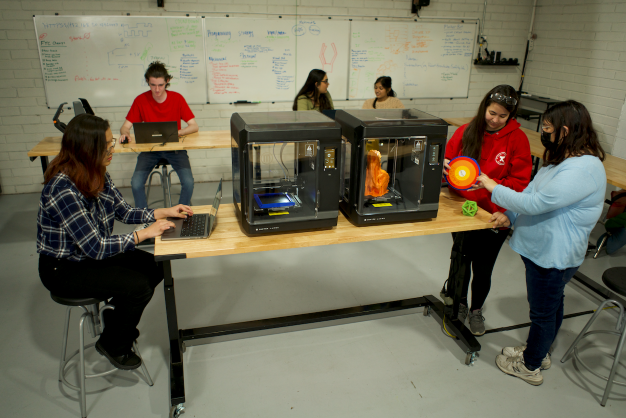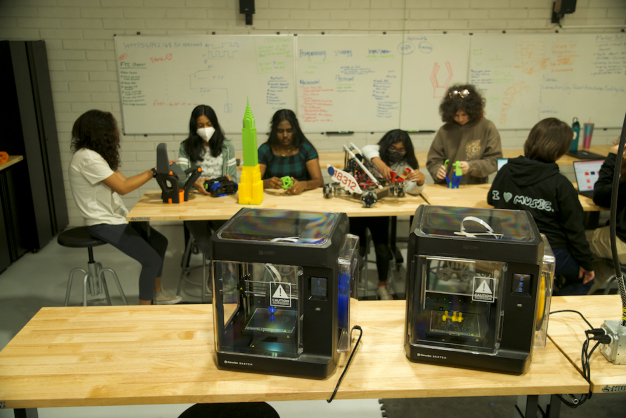Si Se Puede Foundation, based in Arizona, is dedicated to bridging the STEM (science, technology, engineering, and mathematics) divide that exists in marginalized societies. Established over 23 years ago, the foundation started as an advocacy group focused on keeping kids engaged and out of trouble through extracurricular activities, such as soccer and dance. Today, the foundation focuses on providing access to technology and training for students in underrepresented and under-resourced communities and schools.
Designed to support the STEM ecosystem, the foundation’s STEM center offers a wide range of tools and equipment, including MakerBot Sketch and UltiMaker Method X 3D printers, computers, woodworking machines, CNC mills, CNC routers, manual lathes, laser cutters, band saws, grinders, and other basic tools. Si Se Puede offers use of its equipment, at no-charge, to schools—local and beyond—that need access to them.
“There’s a reason we do what we do at the STEM center,” said Faridodin (Fredi) Lajvardi, President and CEO of Si Se Puede. “That’s to get students exposed to all the technology that’s necessary for them to be successful in the 21st century so, when they get into the workforce, they can be contributing members of the economy.”
 When 3D printing becomes part of the STEM ecosystem
When 3D printing becomes part of the STEM ecosystem
The Si Se Puede Foundation hosts student-led robotics teams, which utilize the center to build and test their robots for upcoming competitions, such as the FIRST Robotics Challenge, an international robotics competition for high school students, and the FIRST Tech Challenge which brings together middle and high school students to compete. There are over 19 schools that participate on the robotics teams, which means there are about 50 students who use the center. In addition, there are a dozen other teams, each with about 10 students, that use the facilities. Further, there are over 20 mentors from industry and students from Arizona State University who volunteer in our programs to guide and support the teams.
“Our programs are wildly popular, and we are continuing to get interest. We are nearing a point of maximum saturation,” said Lajvardi.
Located inside the STEM center is the foundation’s new 3D printing center, which is equipped with five Sketch Standard 3D printers, two Sketch Large 3D printers, a Method X, and a Replicator Z18. With the constant flow of students using the center to print prototypes and on-vehicle parts for their robots, the printers are heavily used and are still holding up well, according to Lajvardi.
Lajvardi began using MakerBot printers in 2013, when he was an educator at Carl Hayden High School in Phoenix, Ariz., and coach on the school’s Falcon Robotics team. The team used the printers to produce parts for their autonomous underwater vehicles. With MakerBot printers in-house, the team no longer had to outsource their part production, allowing them to be able to prototype and test parts quicker than before. The students were also able to gain valuable hands-on experience from using the printers, while developing critical design thinking and problem solving skills.
“One of the reasons we continue to use MakerBot is because of the reliability and costs,” said Lajvardi. “You can try to go out there and find a very sophisticated industry standard printer and that would be great, but you can’t get more than one. So, you can’t have a lot of projects going on. MakerBot gives us the perfect platform for students to learn the concepts of 3D printing, and the products that come out of it are more than adequate for all the uses that we’re doing. Out of all the MakerBot printers I’ve used so far, by far the most reliable and the easiest to use is the MakerBot Sketch.”
Daniel Frank, assistant teaching professor at Arizona State University and mentor at Si Se Puede, has also found the printers easy to use with his students. “MakerBot Sketch is very user-friendly, so it’s great for people who are just learning about the technology. I can bring in a student that has little to no 3D printing experience and, through some guidance, we can set up the printer in 15-20 minutes and have our first part printing.”
The 3D printing center was designed as more than just a lab. It plans to offer 3D printing certification courses for educators and students, using the MakerBot Certification™ training program. The goal is to certify teachers and students and empower them with the knowledge and tools to use 3D printing more. MakerBot Certification is the only ISTE-certified 3D printer training program, providing comprehensive curriculum creation courses for educators and design thinking and application courses for students.
“It’s very important for us to certify teachers because if you just get a printer without having any certification, you don’t learn the little tricks and things that you need to know about how to make the printer work perfectly. MakerBot Certification gives the teachers all the tools they need to use the machine effectively,” Lajvardi noted. “For example, I learned that there’s a way that you can clean a jammed extruder using a needle to push through material that’s not fully melted. That’s not something that’s readily understandable to people who don’t have the certification process. Because of that, I’m the only one at the center that knows how to fix the machines. That’s a perfect example of why the certification process is important.”
As the certification program gets up and running, Lajvardi has aspirations to expand their program.
“In an ideal world, we’d like to have enough funding so that if we do a class for teachers, that when they’re done, they go home with a printer,” continued Lajvardi. “It’s frustrating to get certification in 3D printing but you don’t have a printer to use.”
 Teaching the importance of design thinking
Teaching the importance of design thinking
Most of the new students who start using the STEM center have little to no experience using the equipment, much less how to design for them. As a result, it can be intimidating for students to start. But with a little bit of encouragement and training, the worry turns into excitement.
“Initially there’s a little bit of intimidation because the machines are new to them. But once the students have the opportunity to work with these machines, they’re excited and have a lot more confidence,” said Frank. “One of the really great things about 3D printing is that it kind of takes some of the trepidation of, ‘if I make it, I might fail, and it’s going to take time to recover from that or waste a lot of money.’ With 3D printing, it’s okay to fail.”
An important part of building the robots is testing. Not just testing that the final product works, but also testing that each part of the robot works properly. As the students conceptualize, design, and build their robots, they’re given a hands-on tutorial on design thinking and the importance of the iterative process. The mentors encourage testing and prototyping ideas before ultimately finding the perfect design.
“The iterative process makes it possible to continue to achieve the ultimate performance that kids are trying to achieve. Every prototype is analyzed for its success or failures,” said Lajvardi.
Through the foundation, the students learn the entire design and engineering process and how design thinking enables better builds. The skills and knowledge they acquire are invaluable and something they can take with them along their education and career paths.
“One of the most important things about engineering is curiosity. For engineers, we thrive on curiosity because that’s what allows us to find creative solutions to these difficult problems that our world is facing,” Frank continued. “In my classes, I make sure to take time and allow them to nurture that curiosity so that we can have some really beautiful ideas. We talk about wild ideas so, when we’re brainstorming, I encourage my students to put something out there. Maybe it’s not the best idea, maybe it won’t work. Even if it doesn’t work out, it might inspire somebody else who has an idea that could work. So, don’t be afraid to dream, don’t be afraid to think, don’t be afraid to be imaginative.”
Remember, you can post free of charge job opportunities in the AM Industry on 3D ADEPT Media or look for a job via our job board. Make sure to follow us on our social networks and subscribe to our weekly newsletter : Facebook, Twitter, LinkedIn & Instagram ! If you want to be featured in the next issue of our digital magazine or if you hear a story that needs to be heard, make sure to send it to contact@3dadept.com






